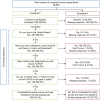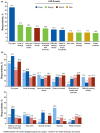Patient-reported symptom burden and impact on daily activities in chronic graft-versus-host disease
- PMID: 36394207
- PMCID: PMC9939096
- DOI: 10.1002/cam4.5209
Patient-reported symptom burden and impact on daily activities in chronic graft-versus-host disease
Abstract
Background: Chronic graft-versus-host disease (GVHD) is a potentially life-threatening complication of allogeneic hematopoietic stem cell transplantation (HSCT) treatment for hematologic malignancies. There are limited patient-reported data concerning symptom burden and effects on activities of daily living (ADL).
Methods: The cross-sectional Living With Chronic GVHD Patient Survey was administered online in the United States (May-August 2020) to participants aged ≥18 years who underwent allogeneic HSCT, were diagnosed with chronic GVHD by a healthcare provider, and self-reported active chronic GVHD (within past 5 years). Information on patient demographics, disease characteristics, symptom burden, and ability to perform ADL was collected. Symptom burden was assessed using the validated Lee Symptom Scale (range from 0-100 with higher scores indicating greater burden). All data were summarized using descriptive statistics; no formal statistical comparisons were conducted.
Results: Out of 580 participants who entered the survey screener, 165 participants (28.4%) across 33 states fulfilled all study eligibility criteria, completed the entire survey, and were included (age: mean [SD], 53.7 (13.8) years; median [range], 57.0 [18-78] years; female, n = 105 [63.6%]; White, n = 137 [83.0%]). Respondents described their chronic GVHD severity primarily as moderate (n = 54 [32.7%]) or severe (n = 102 [61.8%]) at the time when symptoms were at their worst. One-third of respondents (33.9%) indicated that their chronic GVHD symptoms were at their worst for ≥1 year in duration. Mean (SD; range) Lee Symptom Scale score was 44.8 (19.4; 2-100); 44% of respondents considered "dry eye" the most burdensome symptom. Almost half of respondents (n = 73 [44.2%]) rated their overall quality of life (QoL) as poor. Participants reported a detrimental impact of symptoms on ADL, including basic activities (eg, eating, personal hygiene, dressing).
Conclusions: Survey respondents self-reported high chronic GVHD symptom burden and felt that their symptoms severely interfered with physical function and ADL. Effective strategies to mitigate chronic GVHD symptoms are needed to improve QoL among HSCT survivors.
Keywords: QoL; hematological cancer; myeloproliferative disorders; quality of life.
© 2022 The Authors. Cancer Medicine published by John Wiley & Sons Ltd.
Conflict of interest statement
JY, VB, and JG are employees and shareholders of Incyte Corporation. BKH has served on an advisory board for Equilium and Syndax Pharmaceuticals. JT, AV, and OM are employees of IQVIA, the company commissioned by Incyte Corporation to conduct this study. SKS's not‐for‐profit employer has received unrestricted educational grants in the past 3 years from Incyte Corporation, Kadmon, and Pharmacyclics.
Figures






References
-
- Duarte RF, Labopin M, Bader P, et al. Indications for haematopoietic stem cell transplantation for haematological diseases, solid tumours and immune disorders: current practice in Europe, 2019. Bone Marrow Transplant. 2019;54(10):1525‐1552. - PubMed
-
- Magenau J, Couriel DR. Hematopoietic stem cell transplantation for acute myeloid leukemia: to whom, when, and how. Curr Oncol Rep. 2013;15(5):436‐444. - PubMed
-
- Phelan R, Arora M, Chen M. Current use and outcome of hematopoietic stem cell transplantation: CIBMTR US summary slides, 2020. Available at: https://www.cibmtr.org/ReferenceCenter/SlidesReports/SummarySlides/pages.... Accessed July 2, 2021.
Publication types
MeSH terms
LinkOut - more resources
Full Text Sources
Miscellaneous

